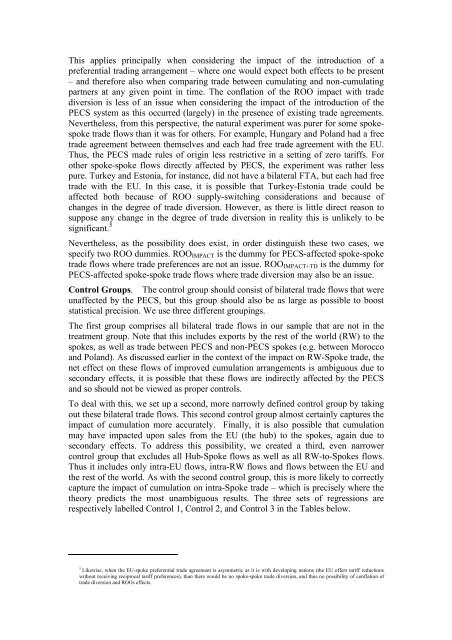PDF, GB, 56 p., 1,3 Mo - Femise
PDF, GB, 56 p., 1,3 Mo - Femise
PDF, GB, 56 p., 1,3 Mo - Femise
You also want an ePaper? Increase the reach of your titles
YUMPU automatically turns print PDFs into web optimized ePapers that Google loves.
This applies principally when considering the impact of the introduction of a<br />
preferential trading arrangement – where one would expect both effects to be present<br />
– and therefore also when comparing trade between cumulating and non-cumulating<br />
partners at any given point in time. The conflation of the ROO impact with trade<br />
diversion is less of an issue when considering the impact of the introduction of the<br />
PECS system as this occurred (largely) in the presence of existing trade agreements.<br />
Nevertheless, from this perspective, the natural experiment was purer for some spokespoke<br />
trade flows than it was for others. For example, Hungary and Poland had a free<br />
trade agreement between themselves and each had free trade agreement with the EU.<br />
Thus, the PECS made rules of origin less restrictive in a setting of zero tariffs. For<br />
other spoke-spoke flows directly affected by PECS, the experiment was rather less<br />
pure. Turkey and Estonia, for instance, did not have a bilateral FTA, but each had free<br />
trade with the EU. In this case, it is possible that Turkey-Estonia trade could be<br />
affected both because of ROO supply-switching considerations and because of<br />
changes in the degree of trade diversion. However, as there is little direct reason to<br />
suppose any change in the degree of trade diversion in reality this is unlikely to be<br />
significant. 5<br />
Nevertheless, as the possibility does exist, in order distinguish these two cases, we<br />
specify two ROO dummies. ROOIMPACT is the dummy for PECS-affected spoke-spoke<br />
trade flows where trade preferences are not an issue. ROOIMPACT+TD is the dummy for<br />
PECS-affected spoke-spoke trade flows where trade diversion may also be an issue.<br />
Control Groups. The control group should consist of bilateral trade flows that were<br />
unaffected by the PECS, but this group should also be as large as possible to boost<br />
statistical precision. We use three different groupings.<br />
The first group comprises all bilateral trade flows in our sample that are not in the<br />
treatment group. Note that this includes exports by the rest of the world (RW) to the<br />
spokes, as well as trade between PECS and non-PECS spokes (e.g. between <strong>Mo</strong>rocco<br />
and Poland). As discussed earlier in the context of the impact on RW-Spoke trade, the<br />
net effect on these flows of improved cumulation arrangements is ambiguous due to<br />
secondary effects, it is possible that these flows are indirectly affected by the PECS<br />
and so should not be viewed as proper controls.<br />
To deal with this, we set up a second, more narrowly defined control group by taking<br />
out these bilateral trade flows. This second control group almost certainly captures the<br />
impact of cumulation more accurately. Finally, it is also possible that cumulation<br />
may have impacted upon sales from the EU (the hub) to the spokes, again due to<br />
secondary effects. To address this possibility, we created a third, even narrower<br />
control group that excludes all Hub-Spoke flows as well as all RW-to-Spokes flows.<br />
Thus it includes only intra-EU flows, intra-RW flows and flows between the EU and<br />
the rest of the world. As with the second control group, this is more likely to correctly<br />
capture the impact of cumulation on intra-Spoke trade – which is precisely where the<br />
theory predicts the most unambiguous results. The three sets of regressions are<br />
respectively labelled Control 1, Control 2, and Control 3 in the Tables below.<br />
5 Likewise, when the EU-spoke preferential trade agreement is asymmetric as it is with developing nations (the EU offers tariff reductions<br />
without receiving reciprocal tariff preferences), than there would be no spoke-spoke trade diversion, and thus no possibility of conflation of<br />
trade diversion and ROOs effects.
















